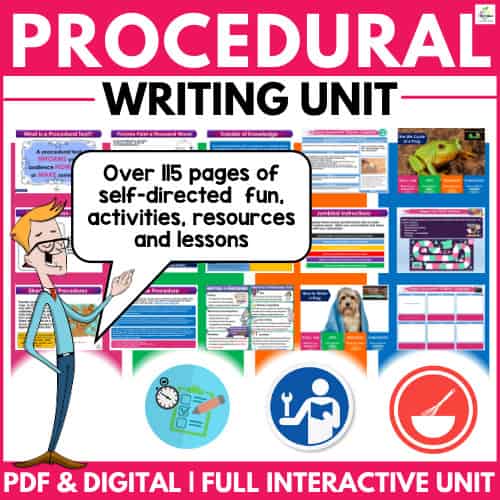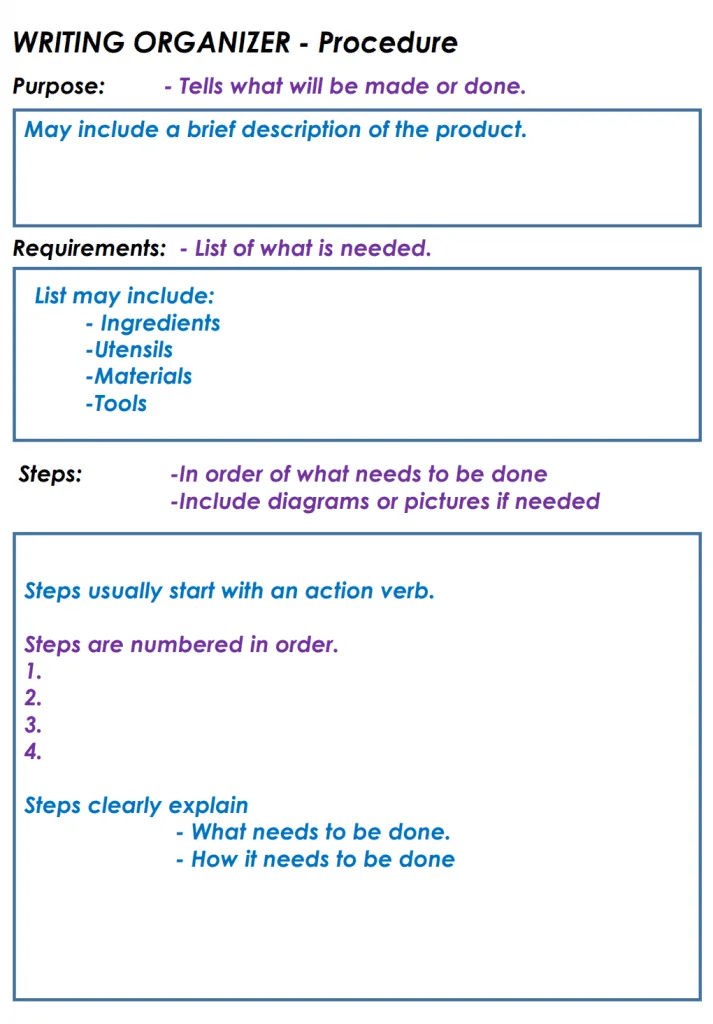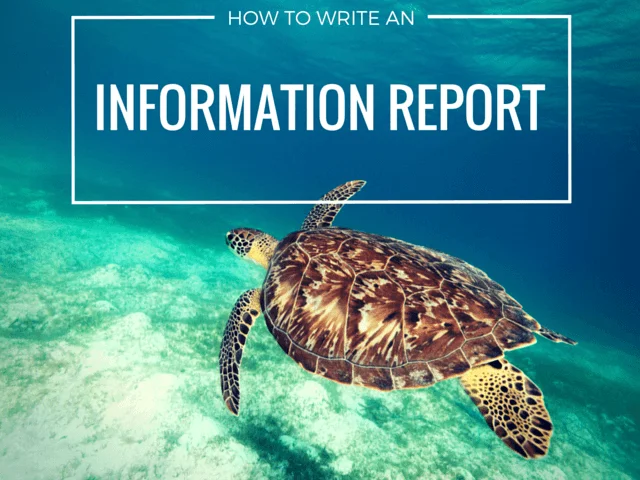
WHAT IS A PROCEDURAL TEXT?

A procedural text instructs your audience on how to complete a specific task. Generally, this falls into two categories, how to make something and how to do something.
The purpose of a procedural text is to provide sequenced information or directions so that people can successfully perform activities safely, efficiently and appropriately.
In some parts of the world, you may encounter procedural writing called a Process Analysis Essay. This title gives students a greater understanding of their purpose of analyzing a process and writing it up as a simple procedure to be followed by the reader.
Having a good grasp of this type of genre writing has multiple possible real-life applications for our students. Luckily for such an important genre, procedural texts are one of the more accessible genres to teach and successfully produce as a student.
As a straightforward nonfiction genre, procedural texts are often easier to grasp for those students who don’t possess a natural affinity for writing than some of the more creative writing genres. In this guide, we will share a series of criteria that will ensure that even struggling students can produce coherent and successful procedural texts with confidence.
TYPES OF PROCEDURAL ESSAY

- Directions – How do I get somewhere? Very specific instructions, including location names and titles. Formal language is required, and the addition of a map will make your instructions so much easier to understand.
- Instructions – How do I do something? Your language must meet the needs of your audience, and you may need to include a diagram if there are complex elements to complete.
- Recipes – How do I cook something? Recipes are universal texts. There is a very clear expectation of the audience, so never stray from the essentials. Ingredients, method and a few visuals are essential.
- Rules for games – How do I play this? Be conscious of your audience and write in a style and language they will understand. You are almost guaranteed to require visuals in this style of writing.
- Manuals – How do I operate this? Are there any warnings I need to be aware of before proceeding? Be very specific in your explanation.
- Agendas – What are we doing? When are we doing it? Who is responsible?
PROCEDURAL AND EXPLANATION TEXTS – WHAT’S THE DIFFERENCE?
An explanation text is similar to a procedural text, which can often be confused. However, an explanation text explains the how and why behind a process, such as
- What causes a Tsunami?
- Why are our rainforests disappearing?
- The process of making aluminium.
A procedure generally instructs the audience on how to make or do something, such as a recipe. Although they have similarities, they are two very distinct writing tasks.
In short, an explanation text is for the THINKER in us as it takes the time to EXPLAIN all the background questions that may arise, whereas a procedure is for the DOER in us, providing a highly efficient set of instructions that exist just to get a PROCESS completed.
STRUCTURE AND FEATURES OF A PROCEDURAL TEXT
PROCEDURAL TEXT STRUCTURE
HEADINGS Titles indicate the goal or aim of your procedure.
SECTIONS Keep everything organised and in order.
SUBHEADINGS Subheadings such as materials, what to do next, warnings indicate the stages of the procedure.
SEQUENCE Everything is organized in the sequence it is to occur and each new step must begin on a new line.
PROCEDURAL TEXT FEATURES
VOCABULARY Use technical and specialized terms in a procedural text. Don’t dumb things down.
TENSE Always write in timeless present tense
FLOW Use connectives and conjunctions related to time to indicate the chronological order of the actions.
DETAILS Details are important in a procedure. Assume very little.
VISUALS Greatly enhance a procedural text and reinforce technical instructions. Maps, diagrams and photos are essential.
LANGUAGE FEATURES OF A PROCEDURAL TEXT
Given the broad range of forms, a procedural text may take, we should not expect that all the structure and features outlined will apply equally to each type of text. However, the following is some valuable general advice for students to bear in mind when they are considering the language registers of their text.
Procedural texts are one of the few writing genres that regularly use the second person pronoun that addresses the reader in a general way. Often too, this ‘you’ will be implied through the use of imperatives at, or near, the beginning of sentences.
Given the nature of these types of text, the simple present tense is the preferred tense for this type of writing. In this regard, it offers an excellent opportunity to focus on verb work, especially on imperatives. These command words, or bossy words, such as cut, take, and hold, are often used to give orders for readers to follow as they move step by step through the process outlined in the text.
This is a nonfiction genre, which should be reflected in the choice of language. There is little to no place here for flights of imagination or figurative turns of phrase. Students should stick to plain, straightforward sentence structures and word choices. They should include detailed factual descriptions of things that will enhance the reader’s understanding; shape, size, color, and the amount should be included where improves understanding.
Sentences should also provide detailed information on how to perform each step in the process outlined. For example, remove carefully rather than simply remove – when care is necessary for satisfactory performance, make sure it is stated explicitly.
Actions should be outlined sequentially, and time connectives can be used to help organize the necessary steps chronologically. For example, the use of adverbial time words, such as: first, second, before, then, and after. Encourage students to focus on answering the questions of where and when of each action they instruct the reader to follow.
HOW TO WRITE A PROCEDURAL TEXT

Now that we have covered the ‘why’ of procedural texts, it’s time to get into the how. Looking at the graphic above, you will see the four pillars of procedural writing to be addressed. Use our free writing template below to help organize your thinking most efficiently and make sure you check out our tutorial video for further clarification if required.
Prewriting Considerations
- What is to be done or made? What is the aim or goal? What might your title be?
- What is needed to complete this? Materials, ingredients, tools and so on.
- In what order should things be done? What are the steps in the process? What is the best way to organize and present them?
- What will you add to your written text to help the audience understand better? ( diagrams, illustrations, pictures etc. )
Take a moment to answer these questions, as a little bit of planning will save you a whole lot of confusion and stress when writing your procedural essay.
1. Purpose / Goal / Aim
This component addresses the what of the piece. It will refer to what is to be done or made. Very often, too, this will provide for the title of the text itself. Often this will be stated in the form of a ‘how to’ sentence or the name of the thing to be made itself. With more technical procedural texts, titles may be more generic and standardized, such as simply Operating Manual or User’s Guide or, in its most basic form, Instructions.
To help your students understand the importance of the title and its relationship with the goal of the text, provide them with a set of procedural texts with the titles removed. In groups, have them brainstorm a variety of titles for the text. When they are finished, reveal the original title of the text and compare it with the suggestions made by the group. Soon they will start to see the pattern evolve, which will help them when they come to produce and name their own procedural texts.
2. Materials / Resources
Usually done in the form of a list, this component may also be titled Materials, Equipment, Ingredients, Items Needed etc. and is pretty self-explanatory. This component comprises a list of things required to complete the procedure outlined in the text. For a recipe, this will obviously include things like ingredients but may also include things like the appliances and tools required to follow that recipe to completion. For flat-pack furniture, for example, items like a screwdriver or spanner, the glue will form this section. Science experiment procedural texts will include apparatus such as Bunsen burners, test tubes, litmus paper etc. Regardless of the specific purpose of the text in question, the resources listed in this section will usually be presented in the order they will be used, as far as this is relevant or possible.
3. Steps
This is the heart of the procedural text as it outlines step-by-step the methodology to follow in the procedure itself. Again, the title of this section of the procedural text may vary depending on the specific type of writing it is. Longer user guides and instructional manuals will have a complex and extensive list of steps to follow that will employ subtitles and subsections to explain micro-processes within the wider procedure being described. More straightforward texts, such as recipes, will be much less complex in structure. It is essential to encourage students to think very logically about the process they are attempting to outline in their writing. Too often, students write themselves into corners as they try to describe complicated procedures while struggling with the technical difficulties of constructing grammatically sound sentences. A good rule of thumb for student writers is to use many short and simple sentences when writing about complex ideas. We will talk more about this aspect when we discuss language features in greater detail.
4. Conclusion
The conclusion of a procedural text offers guidance to the reader on how they can evaluate the success of the procedure that has been followed. This may take the form of, for example, a description of the completed meal for a recipe text or a description of the assembled furniture in a flat-pack instruction guide. Depending on the type of text in question, illustrations can often be used to reinforce what a successfully followed procedure will look like.
USE HEADINGS TO KEEP YOUR READERS ON TRACK
Recipe – Sub Headings (Example)
- Ingredients
- Method
- Serving Suggestions
Science Report – Sub Headings (Example)
- Aim / Hypothesis
- Apparatus
- Method; Results
- Conclusion
THINK LOGICALLY AND ASSUME VERY LITTLE.
The challenge in writing an excellent procedural text is to deliver your instructions logically. Ensure your instructions are straight to the point and that you, as the author understand what you are trying to achieve. You really want to answer three questions to your audience.
- What will I need to complete this task?
- What do I have to do to complete this task?
- How will I know if I completed the task correctly?
Ensure you also clearly understand your audience, as this will have a significant impact on the language you use.
ILLUSTRATIONS: PICTURES PAINT A THOUSAND WORDS

It can often be challenging to describe actions in words – even for accomplished writers. Casting a quick eye over the sports pages of the newspaper will quickly reveal the importance of the visual in relaying information.
You’ll find photographs that convey the commitment and sacrifice of the athlete to their sport far better than most of us can convey with our meagre language skills. The old newsman’s adage A picture paints a thousand words can be just as accurate for procedural texts. But photographs aren’t the only visual means of reinforcing the written word in procedural texts.
Depending on the nature of the text, employ diagrams, schematics, tables, and even cartoons! As with the written text, these images will often be ordered sequentially along with the corresponding text and usually labelled or accompanied by a caption.
HOW TO WRITE A GREAT PROCEDURE VIDEO TUTORIAL (4:30 mins)
TIPS FOR WRITING A GREAT PROCEDURAL REPORT
PROCEDURAL TEXT GRAPHIC ORGANIZER TEMPLATE
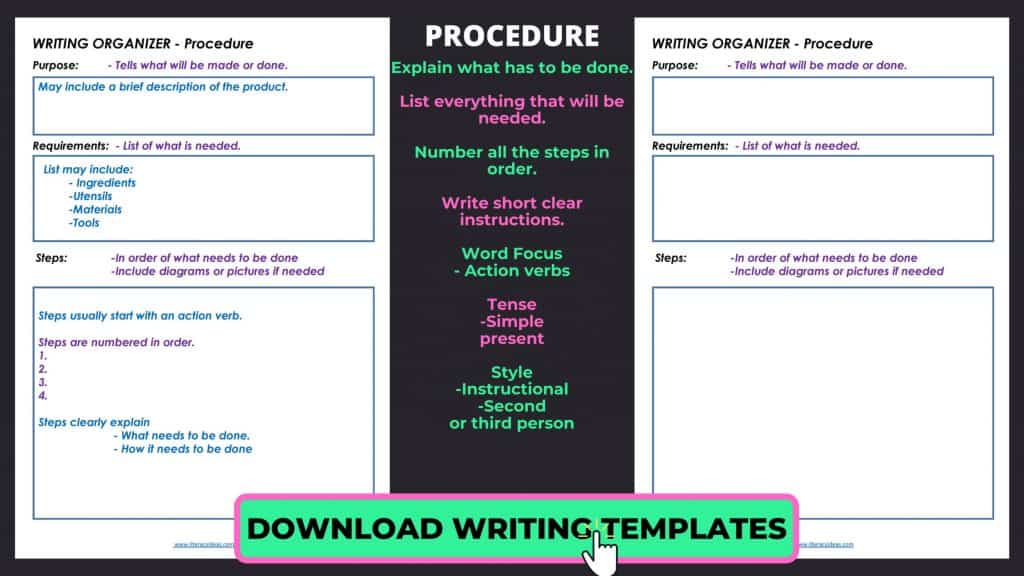
Procedural text ExampleS (Student Writing Samples)

Below are a collection of student writing samples of procedural texts. Click on the image to enlarge and explore them in greater detail. Please take a moment to read the procedures in detail and the teacher and student guides highlighting some of the critical elements of writing a procedure before beginning.
Please understand these student writing samples are not intended to be perfect examples for each age or grade level but a piece of writing for students and teachers to explore together to critically analyze to improve student writing skills and deepen their understanding of procedural text writing.
We would recommend reading the example either a year above or below, as well as the grade you are currently working with, to gain a broader appreciation of this text type.
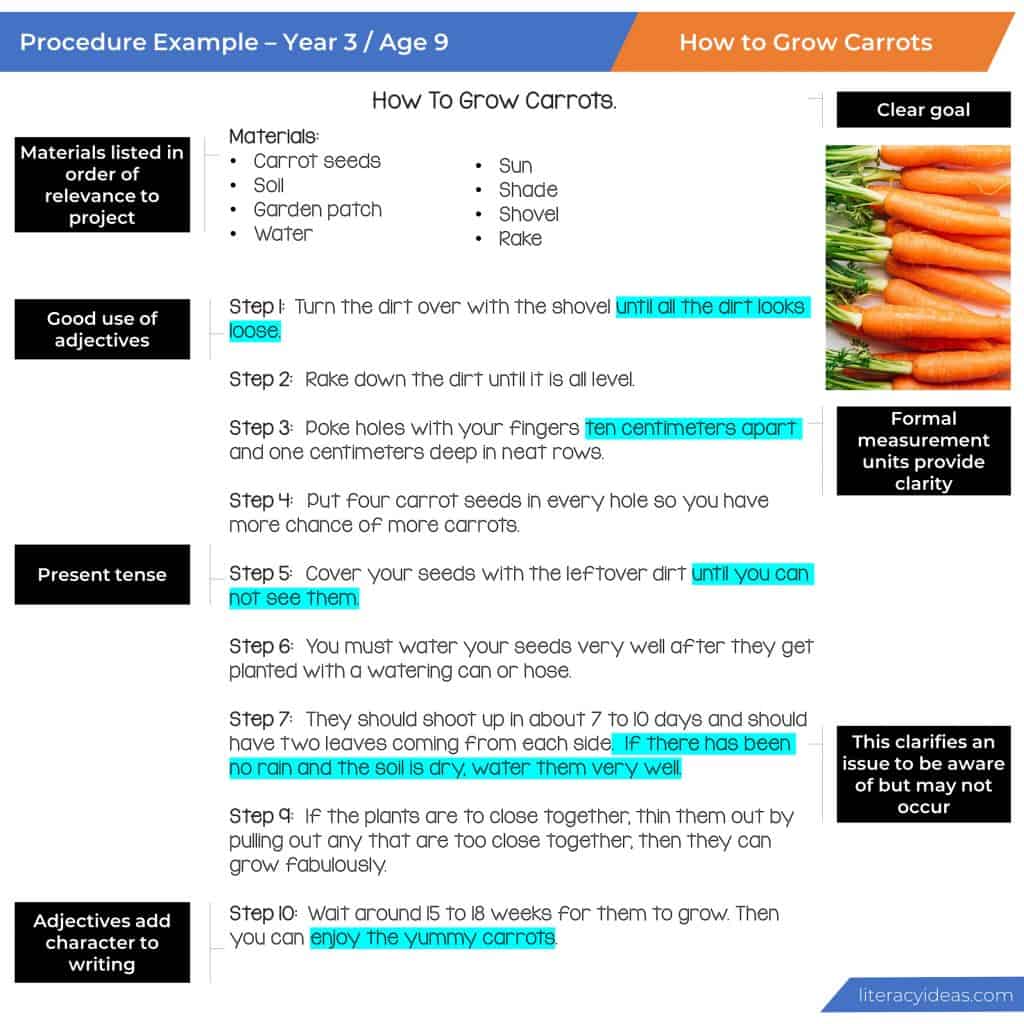


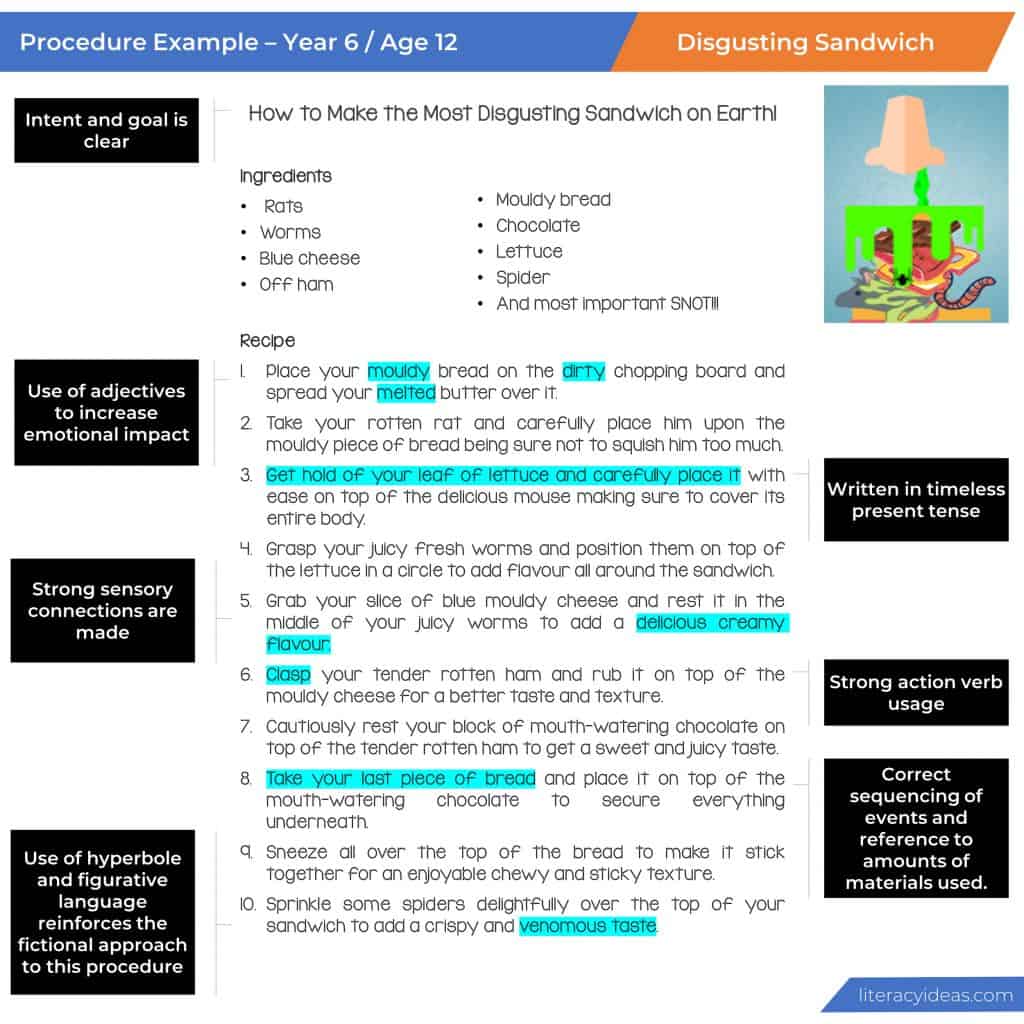


PROCEDURAL TEXT WRITING PROMPTS
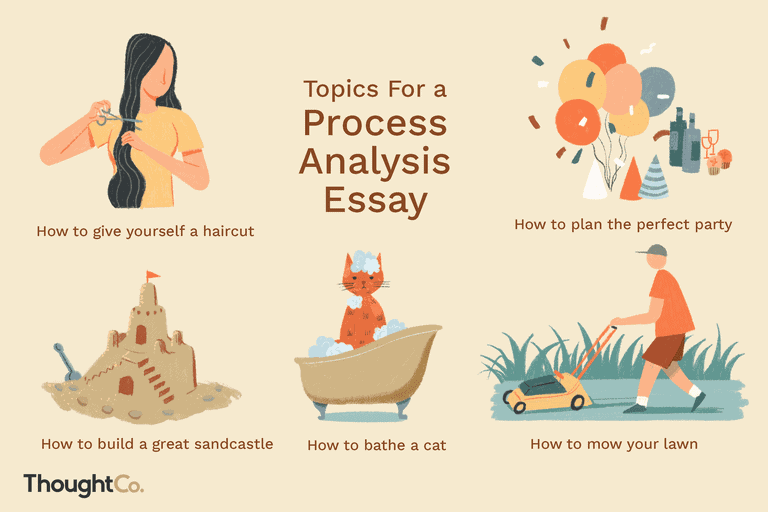
Teaching Resources
Use our resources and tools to improve your student’s writing skills through proven teaching strategies.
TEACHING IDEAS for PROCEDURAL TEXTS
Be sure to check out our guide to mastering procedural writing in a single week here. And if you are looking for an instant, no prep fantastic teaching resource procedural texts, look no further than this unit on TpT.
One of the things that make procedural texts an accessible writing genre for our students is one of the things that can also make it an uninspiring genre for students to engage in, that is, its factual, straightforward nature. There is a reason why we don’t sit up all night reading user manuals! Entertaining the reader is not the priority of a procedural text, and it shows.
So how can we spark the interest of our students strong enough to carry them through the process of producing a completed text? One way is to get creative with the titles of the procedural texts we ask them to produce. For example, if we teach recipe writing, your students may be marginally less than thrilled to be tasked with writing a recipe on ‘How to Make Scrambled Eggs’. Why not add a dash of imagination to it? How about ‘How to Make the Most Disgusting Sandwich in the World’ – now, isn’t that a little more interesting? Sure, no one will actually make the end product – who wants a toenail clipping sandwich garnished in boogers anyways? But, the student will still have to organize their text to the same structures outlined above. They will have to consider the same language features and measure the success, or otherwise, of their writing to the same criteria of a more deadpan procedural text topic.
Another way to ensure student engagement in the writing of procedural texts is to set them a topic that appeals to their own interests specifically. It may be a sporting interest – How to Take a Penalty Kick, a musical one – How to Tune a Guitar or an arts and crafts based task – How to Make a Paper Airplane. All that is needed is a topic that interests the student and one that they have competency in.
Even if the student chooses something they do not have competency in, and if it isn’t too complicated, they may wish to take the learning opportunity and research something new to write a procedural text about based on what they learn. This can be great for longer-term projects and can also be linked to things they have learned in other subjects at school. Reconstructing their learning in this manner offers a wealth of hidden assessment opportunities for the teacher, providing valuable information to inform future planning and provide data for recording and reporting.
PROCEDURAL TEXT SUCCESS CRITERIA AND ASSESSMENT TOOLS
Early in this guide, we outlined the four main components of a procedural text, the last of which was the conclusion. The conclusion, we stated, “offers guidance to the reader on how they can evaluate the success of the procedure that has been followed.” Likewise, in teaching our students to produce procedural texts, we must offer them a means to assess whether or not they have completed the task successfully themselves. One way they can achieve this is by using a Success Criteria checklist. The features students must include can be listed in a column to the left, and in the right-hand column, students can check if they have the feature or quote an example as evidence from their text. For example:

For students to successfully produce their own pieces of genre writing, they must internalize the features of that writing genre. To do this, they must be exposed to successful and unsuccessful examples of the genre to develop a good critical sense. Peer assessment is a suitable means of achieving this. Have your students exchange their work with each other, and, using a template similar to the example above, they can assess each other’s work. This is an excellent method to give your students the practice required to internalize the criteria for successful procedural writing. Varying the number and the complexity of the items on the criteria checklist is a convenient means of catering to different ages and abilities too.
The Proof is in the Pudding
A more practical means of assessing the effectiveness of a procedural text is for students to swap their writing with one another and then carry out the instructions in their classmate’s text to the letter. If they can correctly perform the task exclusively in response to these written instructions, then the writing has been, at least on a purely practical level, successful. Of course, this method does not account for many technical elements that the teacher will still need to check for, but it can be a lot of fun and an opportunity for the students to share their knowledge and interests with one another.
If At First, You Don’t Succeed…
As I stated in this article, procedural texts are one of the more straightforward writing genres for students to master. That said, however, mastery only comes with focused practice. Though structurally, this genre is relatively easy for students to grasp, there are still a lot of language features to consider and stylistic conventions to adhere to. As well as that, there is considerable variation in the complexity of the various types of procedural texts, from simple recipes all the way to complex user manuals. All this takes considerable practice, so it is essential that students are offered regular opportunities to hone the broad range of skills required to write well. Some of this learning will take place in discrete sessions dedicated to the writing of procedural texts, but many of the skills will be developed while working on general language skills, whether focused on verbs, tenses, punctuation, reading etc., it will be useful to make links to principles in common with the various writing genres as and when they arise.
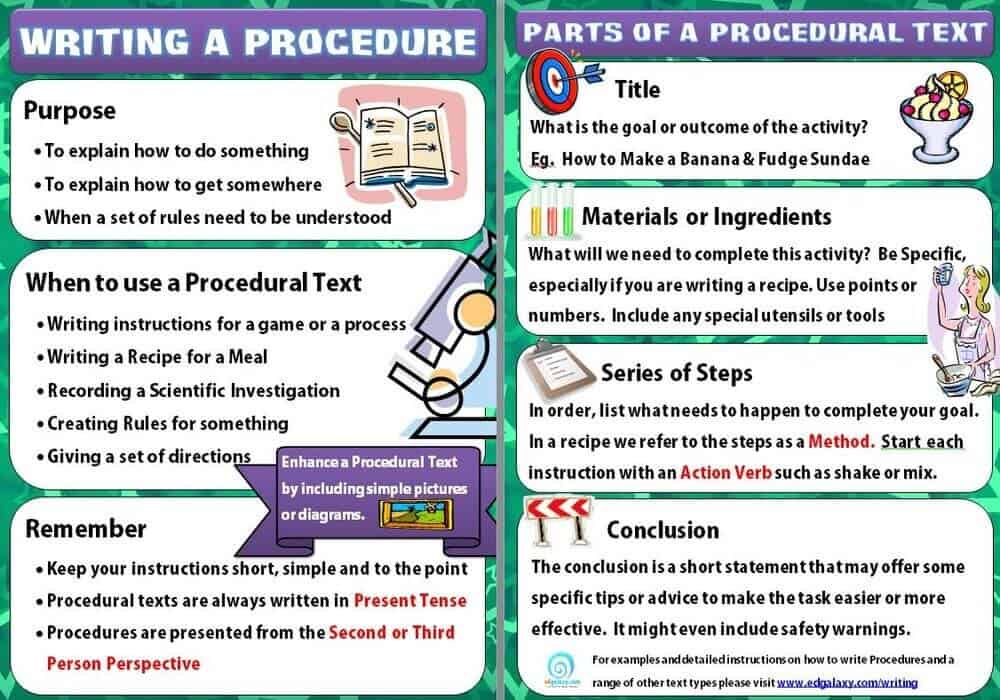
PROCEDURAL WRITING CHECKLISTS
⭐⭐⭐⭐⭐ (92 Reviews)


